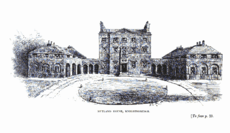Rutland House

Rutland House was the name of at least two London houses occupied by the Earls and Dukes of Rutland.
Rutland House, Aldersgate Street
Rutland House on Aldersgate Street, near Charterhouse Square in the City of London, close to Smithfield Market, was leased by the playwright and impresario Sir William Davenant (1606–1668).
In 1656, freshly released from imprisonment, Davenant turned a room of the house into what was, at first, a private theatre performing his own plays. Soon the performances were advertised and semi-open to the public at a cost of 5 shillings a head, a figure that ensured that only persons of quality would be able to attend. The reason for Rutland House being used rather than a conventional theatre was to overcome the laws of censorship which operated in all public places following the closures of all public theatres by the Puritan government of Oliver Cromwell.
The house seems to have been not totally suitable for theatrical use; however, a low narrow hall, or salon, at the rear of the house was adapted for the performances. Rather than sitting in comfort, the audience had to sit on improvised benches, and so confined was the space available that the benches had to be arranged at an angle to the small stage to accommodate the large audiences who came. The small stage, described by Davenant as a "Cup-board stage", was adorned with gold and purple curtains. Above the stage in what was contemporarily described as a "louver hole" was concealed a small orchestra.
Davenant had seen Italian opera sung in Paris; this inspired him to conceive a cunning plan: as the Puritan government had no objection to music, only drama, he obtained permission to stage a performance of his opera The Siege of Rhodes, to be sung in "recitative music". Thus, the first English opera was performed at Rutland House in May 1656 , simultaneously overcoming the prohibition of drama. The Rutland House production also included England's first professional actress, Mrs. Coleman [1] and was later transferred to the Cockpit Theatre in Drury Lane.[2]
Davenant established at least two other "private performance houses" in Lincoln's Inn Fields and Drury Lane. After Davenant opened more conventional theatres, he continued to use Rutland House to preview new productions, to gauge audience reaction.
Rutland House, Knightsbridge

Another Rutland House occupied a six-acre site in Knightsbridge, then just outside London, from the mid 18th century until it was demolished in 1836. Rutland Gate, a street-cum-square of well-proportioned houses was erected on its site.[3][4] It was built for John Manners, 3rd Duke of Rutland.
Notes
- ↑ https://www.gutenberg.org/dirs/4/1/2/4126/4126.txt
- ↑ https://www.gutenberg.org/dirs/1/4/3/8/14380/14380-8.txt
- ↑ Some Account of the Military, Political and Social Life of the Right Hon. John Manners, Walter Evelyn Manners, Macmillan and Co. Limited, London, 1899
- ↑ Survey of London, Volume 45, John Greenacombe (general editor), London, 2000, English Heritage, British History Online
External links
- Penny McIsaac, "Where were plays performed before the opening of the playhouses?"
- Rutland House, Knightsbridge from the Survey of London
Coordinates: 51°31′09″N 0°05′49″W / 51.519052°N 0.096946°W